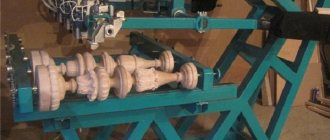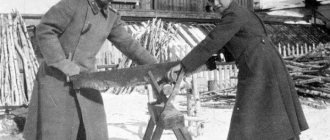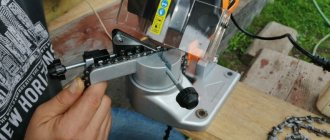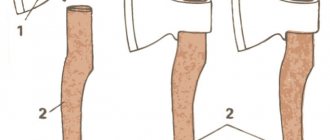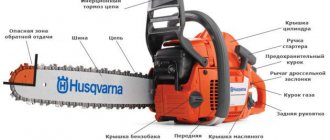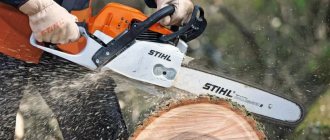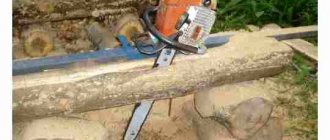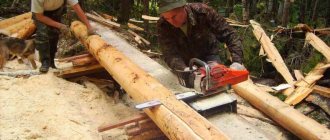It is better to postpone the first launch of a new chainsaw and testing its operational capabilities until you have acquired theoretical and practical training for work, the features of routine maintenance and techniques for performing the simplest sawing work. How to use a chainsaw so that mistakes made in the work do not affect the technical condition of the tool and its working life?
Recommendations from experts can be divided into 4 main groups, primarily:
- theoretical and practical training;
- development of the startup process sequence;
- developing techniques for using the instrument;
- full technical service.
Preparation of a flammable mixture
Regardless of status, power and purpose, the chainsaw is powered by a two-stroke internal combustion engine running on a mixture of high-octane gasoline and motor oil.
As a rule, it is recommended to use branded consumables, but choosing an analogue with identical characteristics from the ranges of other leading manufacturers is also not excluded.
The proportion specified by the developers is indicated in the attached instruction manual. In most cases, the oil to gasoline ratio is 1:40 or 1:50. The finished mixture cannot be stored for long periods of time, so it is prepared in quantities sufficient for one-time use.
Basic safety rules
How to use a chainsaw of a particular model is not written anywhere better and more accurately than in the corresponding instructions from the manufacturer (and instructions always accompany such products).
A detailed study of it will clearly not be a waste of time. The main components of the instrument, features of startup and maintenance, and safety precautions are indicated there.
On the other hand, there are general rules for working with a chainsaw and safety principles that must be followed regardless of the brand of the tool and the experience of the master.
Equipment
Even if you only need to cut a few logs into firewood for the stove, it is worth wearing protective equipment. The head must be wearing a helmet with a face mask and headphones. Gloves made of hard material are put on your hands.
When felling trees, wear a brightly colored jacket made of durable fabric and cut-resistant pants. Of course, more requirements are placed on the equipment of a professional feller than on the clothing of an ordinary person. But in any case, it should be comfortable, wear-resistant, breathable, and should not hinder movement during work.
It is advisable to wear boots or other closed, comfortable and durable shoes on your feet. The lower part of the trouser legs should not flutter in the wind. For professionals, they produce special boots with steel plates that protect the lower leg from possible cuts.
Refill features
It is recommended to fill the fuel into the tank through a funnel with a fine-mesh filter, which prevents water and small debris from entering the fuel system.
This measure is compensated by the impeccable operation of the carburetor. In addition to the gas tank, in the saw body there is another reservoir for chain oil; the symbols on the lid will help you determine the correct neck.
The lubrication system supplies special oil to the working area to cool the saw set and extend its service life. Filling the oil system with waste or other oil substitutes negatively affects the durability of the pump, bar and saw chain, as well as the performance of the chainsaw as a whole.
How to prepare a chainsaw for work
Before starting the chainsaw engine, you need to prepare for work. Preparation includes filling the tool with fuels and lubricants. This motorized unit consists of a two-stroke internal combustion engine. Such an engine cannot operate on gasoline with a pure octane number, so the preparation of a gasoline-oil mixture is necessary.
Filling the chainsaw with oil to lubricate the chain
- The ratio of the gasoline/oil mixture corresponds to 1 liter of gasoline and 20 grams of oil. Moreover, the oil used is specialized for two-stroke engines. After mixing these two substances, you can pour the mixture into the tool tank. Usually there is a picture of a gas station on the filler hole of the tank.
- Filling with oil used to lubricate the chain during operation of the unit. Typically, the oil tank filler hole is located on the opposite side of the fuel hatch in the area where the tire is located. To lubricate the chain, it is recommended to use only branded oils from reliable manufacturers. Filling motor oils with viscosity W30-W40 is unacceptable, and it is also strictly contraindicated to fill in waste
Before starting, you need to remember to check the tension of the chainsaw chain. If the degree of tension is weak, then tension is required. During operation, the amount of fuel and lubricants in the tanks is periodically monitored. The oil tank is 2 times smaller than the fuel tank, but the consumption is the same.
This is interesting! Chain lubrication oil and gasoline oil mixture must be poured into the corresponding openings of the tanks at the same time, since their consumption is uniform.
Cold engine starting sequence
The technology includes checking the filling of the tool with fuel and oil, monitoring the chain tension, and turning on the emergency stop brake. In this position, after starting the engine, the operation of the headset is blocked.
- To safely turn on the power unit, the saw must be installed on a level base, enrich the mixture by covering the air damper, secure the tool by grabbing the front handle with your left hand, and pull the starter handle without jerking with smooth acceleration.
- It is considered normal if the engine starts after 2-3 attempts. To start a hot carburetor drive, it is not necessary to enrich the mixture with the air damper.
- After making sure that there are no foreign objects under the tire, you can disable the emergency stop system and return the choke to its original position. Warming up the engine for a long time at idle is not recommended due to oil starvation.
Basic operating principles
If you have never worked with a chainsaw and have no experience handling it, you need to understand the basic principles of working with this tool:
- You need to hold the saw with both hands, clasping the handles with all your fingers. The left thumb should be under the front handle;
- while working, you cannot stand directly behind the saw; it is advisable to be slightly to the side of the tool;
- You can cut using both the lower and upper edge of the tool. If you cut with the bottom edge, the chain will move the saw away from you, and if you cut with the top edge, the chain will move the saw towards you;
- When using a chainsaw, try not to bend your back; instead, it is better to bend your knees. When working with a saw in a standing position, it is recommended to keep your feet wide apart to maintain balance;
- Before moving to another place, you must activate the saw brake or turn off the tool motor. You cannot move with a tool whose chain rotates;
- sawing should begin with the section of the tire closest to the tool body;
- If you are going to work with a chainsaw often, you must definitely purchase a set of protective clothing: a helmet with a mask, a bright protective jacket that does not allow air to pass through, special trousers that have protection against cuts, strong mittens and durable boots, which should be protected if possible steel plates.
Checking the operation of the lubrication system
Chain oil is supplied to the working area under pressure by built-in pumps with constant or adjustable capacity. In order to check the intensity of oil supply to the tire, it is enough to place a sheet of white paper under it and briefly bring the engine to operating mode.
By the presence and size of the oil strip, one can judge the operability of the lubrication system and its performance. It is prohibited to operate a chainsaw with a non-functioning lubrication system due to overheating of the headset and its premature failure.
The principle of operation of a chainsaw
To understand the principle of operation of a chainsaw, you need to consider its structural components.
These include:
- an engine equipped with a crankshaft, cylinder and piston;
- manual starter - consists of a reel on which a cable is wound. To return the spring to its original position, a spring is provided in the mechanism;
- fuel system - includes a carburetor and fuel hoses;
- clutch - required for continuous connection between the engine and the sawing parts of the chainsaw;
- ignition - responsible for supplying the spark necessary to ignite the fuel mixture;
- saw set - consists of a bar and chain;
- lubrication system – necessary to supply oil to the headset;
- tension mechanism - required to adjust the chain on the bar.
The basis of the operation of a chainsaw is the operation of an engine that operates on a fuel mixture.
When the starter cable is pulled, the ignition system is activated, which generates a spark and transmits it to the cylinder. There, the fuel ignites and activates the piston, which in turn begins to rotate the crankshaft. He, through the clutch mechanism, causes the sawing bodies to rotate. An oil pump is responsible for the stable operation of the headset under conditions of increased friction and heating, which supplies lubricant to special grooves provided on the tire. From these, the oil is evenly distributed onto the chain. Thanks to this principle, the tire and chain can withstand increased loads and work in extreme conditions.
To stop the bar and chain in order to reduce the risk of injury to the operator, the gas saw is equipped with an inertia brake. It is triggered by a kickback caused by contact of the chain with a nail or wire.
Safety precautions when developing working skills
A chainsaw is included in the list of hazardous household tools, so the operator, regardless of the complexity of the work, is required to constantly monitor his actions. Find out right now how to cut with a chainsaw correctly.
- The rules provide for the use of special sawyer equipment, which includes overalls, shoes, a safety helmet, mittens and goggles.
- The design of the chainsaw provides a reliable grip when working from any position, but it is not advisable to hold the working tool directly in front of you. It is safer to position the saw so that the operator's feet are away from the cutting line.
What kind of work can be done with a chainsaw/power saw?
The chainsaw has proven itself well in the following types of sawing:
- Felling trees
- Blooming tree trunks into logs (harvesting firewood)
- Trimming scaffolding
- Cutting boards to size
Of course, the scope of modern chainsaws is wider. To the above types of sawing, you can also add a lot of specialized, narrow-profile work: cutting stumps when uprooting, trimming wooden structures when dismantling them, preparing blanks for the manufacture of products from solid natural wood, and so on. But let’s dwell on the above types of sawing. They are basic.
So, how to work with a chainsaw correctly.
Pro recommendations
In addition to the basic rules, there are a number of useful recommendations that can improve the productivity of sawing work without violating safety rules.
First of all:
- before starting work, it is necessary to remove from the workplace all foreign objects that impede free movement;
- during work, uncomfortable postures that contribute to the rapid accumulation of fatigue are not recommended;
- Excessive bending or holding a running chainsaw at outstretched arms or above shoulder level is undesirable;
- at the beginning of each new cut you should be especially careful, since there is a high probability of kickback;
- You should also abandon the practice of sawing wood of any diameter with the end of the headset.
The technology does not exclude work on both sides of the tire. The main thing to remember is that sawing wood with the bottom side moves the tool forward, and the top side creates the opposite effect.
How to use a chainsaw?
In order for a garden chain tool to last as long as possible, the operator must learn the basic rules of its operation.
These include:
- Before cutting wood, the saw motor must warm up. To do this, after starting a cold engine, you need to give it 5-7 minutes to warm up. During this time, the oil will be distributed throughout the moving elements of the internal combustion engine and ensure their stable operation;
- After warming up, the operator should cut only thin branches. It is impossible to immediately subject the engine to increased loads, as this can lead to serious damage to the crankshaft and the formation of burrs on the inner surface of the cylinder;
- When sawing thick wood, you need to work with a chainsaw intermittently. They are needed to cool the engine. The correct interval includes 20 minutes of work and 10 minutes of rest;
- Before each start of work and shutdown of the chainsaw, you need to gas the engine. To do this, the operator must sharply press the throttle trigger several times and quickly release it.
If a garden tool breaks down, the operator is required to quickly find the cause of the problem and try to fix it. Otherwise, the tool will work under increased loads, which can lead to even more serious problems.
Advantages of traditional technologies
When felling large trees, it is recommended to use simple and time-tested methods, in particular, making diagonal and horizontal cuts of ¼ and 9/10 of the trunk diameter.
This method is suitable for target laying of the trunk in a given direction. To prevent the bar from being clamped in the cut, wooden wedges are used, which do not damage the saw chain in case of accidental contact.
- It is possible to clear the trunk of thick branches and cut logs located on an inclined surface only after they are securely fixed. The gripping of the soil by the saw bar is prevented by laying the trunk on placed wood scraps with a diameter of 100 mm.
- Trimming branches and sawing firewood with a tool with a dull chain is not economically profitable due to reduced productivity and excessive fuel consumption.
- It is more convenient to cut out planting nests in construction wood and saw boards with a chainsaw with a short bar.
In the process of mastering the capabilities of a chainsaw, each owner develops his own style of work, but for productive and safe operation of the tool, it is important to comply with general requirements and recommendations.
Tips for the home handyman. How to use a chainsaw
Tools used: chainsaw Makta DCS 7900 (professional); chainsaw Makta DCS 3435 (amateur). Those who do not yet have experience using a chainsaw should remember the basic principles of working with this tool:
– the saw must be held with both hands, and the handles should be clasped with all fingers. In this case, the thumb of the left hand should be under the front handle;
– when working, you cannot stand directly behind the saw; you need to stand slightly to the side of the tool;
– you can cut with both the upper and lower edges of the tool. When sawing with the bottom edge, the chain guides the saw away from the user. When sawing is done with the top edge of the tool, the chain moves the saw towards the user;
– when working with a chainsaw, it is not recommended to bend your back. It is better to bend your knees. When working in a standing position, you need to spread your legs wide to maintain balance;
– when moving to another place, it is necessary to turn off the engine of the tool or activate the brake of the saw. You cannot move with a saw whose chain rotates;
– you need to start cutting with the section of the tire that is located closer to the body of the tool;
– if you plan to frequently work with a chainsaw, you need to purchase protective clothing: strong boots (preferably special ones protected with steel plates), strong gloves, special trousers with cut protection, a bright protective jacket that allows air to pass through, and a helmet with a mask.
1. Preparation for work
Before starting work, check the chain tension - it must be carefully adjusted so that the chain does not sag on the bar during operation. A poorly tensioned chain wears out the bar and sprocket faster, damages the shock absorbers faster and increases the load on the tool body.
IMPORTANT!!!
– before you start working with a chainsaw, you must read the user manual;
– if the saw chain is new, it is recommended to immerse it in oil for several hours before starting work. If the chain is old, it is necessary to sharpen it: the cutting tools of a poorly sharpened saw wear out quickly.
2. Refilling the saw with gasoline and oil
The saw is placed on a stable surface and fueled. For refilling, you should use only “branded” oils designed specifically for chainsaws. The percentage of oil in this mixture should be 1/40-1/50. To operate imported saws, it is better to use 92-grade gasoline (or a higher grade), while 76-grade gasoline is also suitable for Russian saws.
IMPORTANT!!!
– to avoid the risk of fire, before starting the engine, the saw is removed from the place where it was filled with fuel and placed again on a solid, stable base.
3. First launch of the tool
After checking that the chain does not touch hard surfaces, turn on the chain brake. In this case, the brake handle is moved away from you so that the chain does not start to rotate ahead of time. Since the engine is cold, the choke control lever is pulled out completely. The toe of the foot is threaded into the rear handle (while holding the front handle with your hand). Pull the handle several times, pulling out the starter cord, until the engine “sneezes.” After which the air damper is moved to the working position and the saw is started. Briefly press the throttle and set the saw to idle. The brake handle is moved back to its previous position. The saw is ready for use.
IMPORTANT!!!
– before work it is necessary to check the brake of the tool. To do this, place the saw on a flat surface and press the throttle. The brake is activated by pressing the handle without releasing the handle of the tool. If the chain stops, the brake is working properly;
– You should also check the lubrication mechanism before work. You need to find some light surface (for example, a freshly cut stump). Hold the tool over the stump, start the chain and increase its speed by pressing the throttle. If a streak of oil appears on the stump, then the lubrication mechanism is in order.
4. Pruning branches
Trimming branches from the trunk of a fallen tree begins from the bottom of the trunk, standing to the left of it. Work is carried out at a slow, calm pace, trying not to use the nose of the saw. Saw with both the top and bottom of the tire, trying to lean the saw against the thigh or trunk if possible. Branches from the top of the trunk are cut down by placing the tool on its side (the saw should rest on the trunk with all its weight). After the branches on top and on the side of the lying trunk are cut off, the trunk is turned over and the branches that were below are cut off.
IMPORTANT!!!
– it should be remembered that sometimes the entire trunk can rest on only one branch: if it is cut, the trunk may move or roll;
– if the branch is thick, you need to cut it down in parts - from the end to the trunk. If the branch is particularly thick, it may require sawing on both sides.
5. Bucking (sawing the trunk into pieces)
Bucking begins when all the branches have been cut from the trunk. The trunk of a lying tree is cut into pieces in the direction from the trunk to the top (butt).
IMPORTANT!!!
– during the bucking process, it is prohibited to stand below the trunk if it is located on an inclined plane;
– if the saw is stuck in the trunk, you need to stop the engine and tilt the trunk until the saw comes out of the wood. There is no need to immediately remove the saw from the tree.
6. Tree felling
Before cutting down a tree, they determine in which direction it will be “more convenient” for it to fall. To do this, take into account the natural slope of the trunk, the direction of the wind and the number of branches on each of its sides. The tree must be felled in the direction in which it is “more convenient” for it to fall. Immediately before felling, you need to cut off any low branches that could interfere with the work. There are several technologies for felling trees, which are selected depending on the thickness of the trunk and other factors. Only a professional lumberjack can choose the best method.
IMPORTANT!!!
– if there are people nearby, they should be at a distance of at least 2 tree trunk lengths;
– before starting work, you should make sure that there is nothing around that could be damaged by a fallen tree;
– felling trees is not an easy task: if you do not have experience in such work, it is better to entrust this task to professionals or ask them to be present during the work!
Instrument care
Each time after working with a chainsaw, you must do the following:
1. Check chain tension and lubrication.
If the chain is loose, it needs to be tightened; if the oil runs out, add it to the tank.
2. Refueling.
When finishing work, you should refuel the machine after a short rest to allow the saw to cool down.
3. Checking the air filter.
From time to time, the filter becomes clogged with chips; after finishing work, it is advisable to remove it, wash it and blow it out. It is also necessary to periodically clean the surfaces around the engine cooling plates from contamination.
remont.blizko.ru
Routine tool maintenance
After use, the tool, especially the saw bar and air intake, should be cleared of sawdust and debris. Failure to comply with this requirement affects the efficiency and traction characteristics of the engine, and difficulties with starting are also possible.
Constant monitoring of the tension and quality of chain sharpening, correct adjustment of the lubrication system, allows you to reach 100% service life of the headset.
The risk of injury is reduced by the effective operation of the emergency braking device and the broken chain catcher design. With timely maintenance and proper operation of the chainsaw, the likelihood of such situations is almost zero.
First start of the chainsaw
A new chainsaw cannot be immediately operated under maximum load. All rotating parts of the tool must first rub against each other. It is recommended to use a full gas tank when starting for the first time, without applying high forces to the saw . If such a test is successful, you can subsequently cut with a chainsaw without additional restrictions.
The chainsaw is started on a flat horizontal platform. The starting procedure using the example of a Stihl saw should be as follows.
- Manually pull the chain along the bar, making sure it moves smoothly and there is no excessive resistance.
- Engage the chain brake by moving its handle away from you.
- Open the cylinder decompression valve.
- Feed the fuel mixture into the carburetor with a few clicks on the primer.
- To properly start the saw, you need to press the rear handle with your right foot to the ground. Hold the front handle with your left hand and lock the fuel supply lever in the working position with your right.
- Place the combination switch in the cold start position.
- With a jerk of the starter handle, start the ignition of the engine, which should stall almost immediately.
- Open the throttle valve to the half throttle position.
- By pulling the starter cable again, start the engine again, immediately turning the fuel lever to the idle position.
- Pull the chain brake handle towards you, moving it to the working position.
- By holding the far end of the guide bar to a clean, bright surface, check that the chain lubrication system is working by sprinkling small drops of oil.
After making sure that all components and mechanisms of the saw are in good working order and do not make any extraneous noise at idle, you can proceed to work under load.

